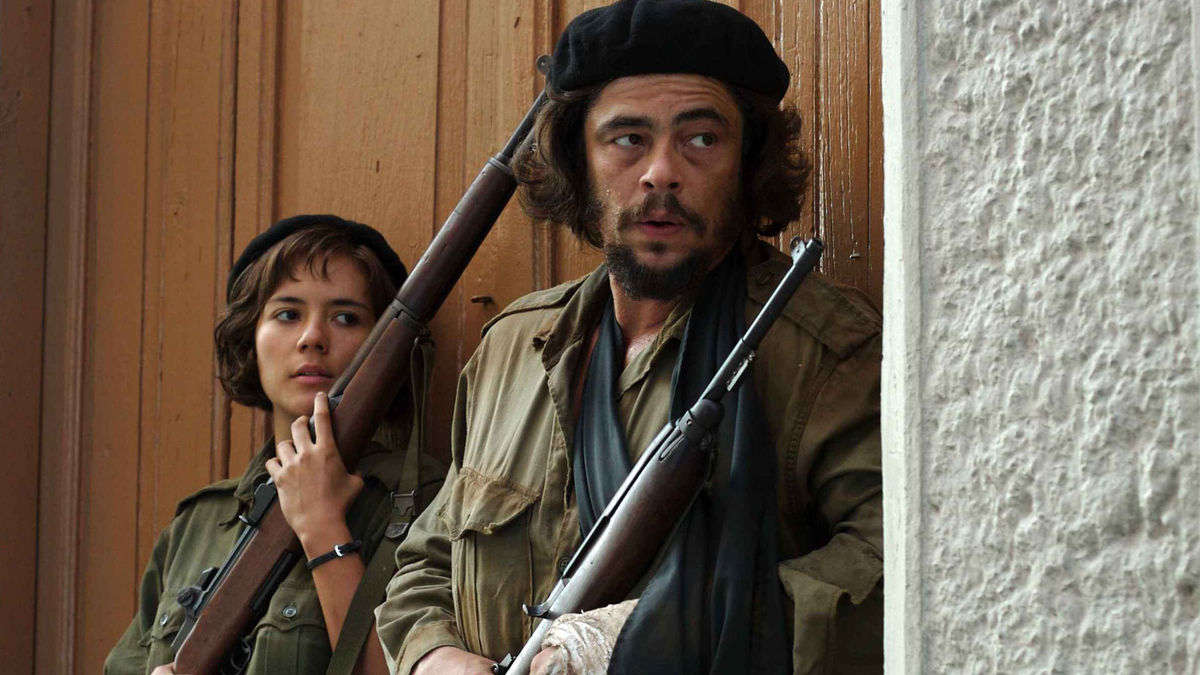By Chlotrudis Independent Film Society
Rating: 3 cats
Director: Stephen Soderbergh
Starring: Benicio Del Toro | Demián Bichir | Julia Ormond | Oscar Isaac | Ramon Fernandez | Rodrigo Santoro

Country: france, spain, united_states
Year: 2009
Running time: 126
IMDB: http://www.imdb.com/title/tt0892255/
Jason says: “At various times, Steven Soderbergh’s ambitious Che Guevera project has been described as one very long picture and as two, and I’m not sure which is how it started and which is considered the definitive experience. To further muddy the waters, I saw CHE as a single feature with an intermission, but it separates into two distinct (though connected) films in my mind. Part One is the weaker of the two, but it does set up themes that are important for the second.
“The film opens (after a graphical lesson in Cuban geography) in 1964, with Ernesto ‘Che’ Guevera (Benicio Del Toro) in New York to address the United Nations. The bulk of the time is spent in flashback, as we follow Guevera’s first meetings with Fidel Castro (Demián Bichir) in Mexico. From there, they go to Cuba, where Guevera first serves as the rebel army’s medic before being placed in charge of a new column which advances 150 on foot from the mountains in the southeast to the central part of the island. We’re introduced to many other members of Castro’s army, including Aelida (Catalina Sandino Morena), a messenger who would eventually become Guevera’s wife.
“Aficionados of this segment of history and people with particular interest in Che Guevera will likely find this film intriguing, while the rest of us may find it very dry. The film probably doesn’t spend as much time introducing us to various people – literally, often with the template of ‘I’m Che.’ ‘I’m Ramon.’ ‘How old are you?’ ‘Twenty.’ – as I remember, but does so enough for the audience to notice the pattern. We can infer some purpose to it – noting that Guevera’s stances on using teenagers and how his soldiers should be able to read and right weaken as time passes, maybe, although there’s not much outward indication that the situation is becoming desperate. It comes across as Soderbergh and company wanting to touch upon as many figures from the Cuban Revolution as possible for completeness’s sake. We are basically being told that these people are important historically, even though they don’t obviously affect the film’s narrative.
“The film also has what feels like an overly-sympathetic view of its title character, at least at first glance. The film frequently takes great care to note that Che insists upon only engaging military targets, and the interview segments tend to present him at his very best, saying things like how love for the people is the most important trait for a revolutionary to have. Che’s better qualities are so directly presented to us that it’s very difficult to see his bad side, which must be inferred: There’s a powerful ego to be seen in his advancing on the last offensive without waiting for the group his was supposed to meet, and how concerned he is about who will be allowed to speak from the podium and the floor. Perhaps the most telling scene is when he expresses relief that another physician has joined the cause, so he can shift his attention from saving lives to ending them. There are several moments like that in the film, but they must be hunted for, compared to the praise that is clear for all to see.
“Benicio Del Toro mostly seems interested in playing the heroic Che, albeit in a fairly restrained manner. I will readily admit that I may be missing a lot in translation; his entire performance is in Spanish and there may be intonations I don’t catch by concentrating on subtitles or the overlapping voice of Che’s translator. Del Toro does get across the man’s passion, and how uncomfortable he is during his trip to New York. The rest of the cast is good, although not a one of them manages to stand out as terribly memorable.
“Soderbergh does manage to make a fairly impressive movie visually: For as much as this is the story of one man, the battle sequences are grand, filled with people and shot from interesting angles. The digital photography is is sharp and clear, capturing the lush colors of the jungle beautifully. Scenes in New York, by contrast, are shot in grainy 16mm monochrome; the contrasting style is an often-used idea, but one that works well enough.
“Seen alone, CHE: PART ONE is likely a bit unsatisfying, perhaps needing the second part to bring the title character’s faults into focus. Even with that second half, it still comes across as striking an imperfect balance, presenting the facts of the Cuban Revolution without much emotion and making the audience work at finding Che an interesting or complex figure. 3 cats”
